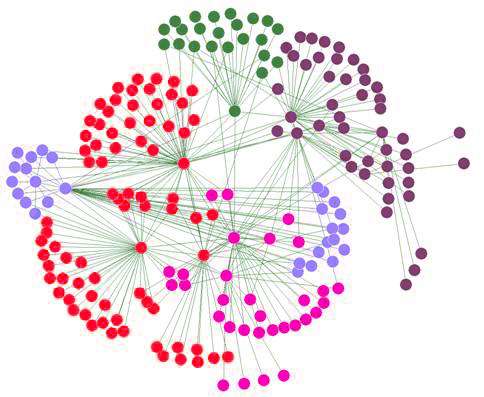May 18, 2016 report
Study shows people have an upper limit on the number of friends they can add to their social network

(Phys.org)—A pair of researchers has found when people add someone new to their "friends" list, each is more distant than those in the inner circle. In their paper published in the Journal of the Royal Society Interface, Michael Harré and Mikhail Prokopenko, both with The University of Sydney in Australia, describe test data they analyzed covering both hunter-gatherer societies and people living in modern conditions, what they found and what it might mean for people moving forward using virtual social networks.
Prior research has shown, the researchers note, that humans are only capable of maintaining a certain number of people in their social world, currently, the upper limit appears to be 132 people. But, not all of those people are directly connected to any one individual, it all happens through links. Harré and Prokopenko suggest the upper limit on the number of direct friends for most people is about five. The upper limits appear to be based on biology, they note—as the human brain developed, people were living together in small groups that lived as hunter-gatherers. That led to the development of links, which are direct connections between two people, generally two people that have some type of emotional attachment. To form a larger group, it isn't necessary for every person in that group to form a connection with everyone else, all it takes is for a network of connections to exist.
In primitive terms, the researchers explain, that would mean that not all of the people in a small hunting party would necessarily have to be friends, instead, each would have to be friends with just one or two of the people in the group. They have calculated that to have a social circle of 132 people, each person would only have to have a link with just five people. They also have found that the number of links a person has can be related to group size, as the group grows, more links are needed to maintain cohesiveness. As it grows to 15, for example, there will exist on average 3 links per person; in groups of 45, the number of links would grow to 3 or 4.
The researchers also suggest that their findings help explain how modern societies have come to deal with networking—by forming hierarchies. In such groups, people don't have to know hardly anyone to be a part of the overall group, instead, the group is made functional by leaders.
More information: Michael S. Harré et al. The social brain: scale-invariant layering of Erdős–Rényi networks in small-scale human societies, Journal of The Royal Society Interface (2016). DOI: 10.1098/rsif.2016.0044
Abstract
The cognitive ability to form social links that can bind individuals together into large cooperative groups for safety and resource sharing was a key development in human evolutionary and social history. The 'social brain hypothesis' argues that the size of these social groups is based on a neurologically constrained capacity for maintaining long-term stable relationships. No model to date has been able to combine a specific socio-cognitive mechanism with the discrete scale invariance observed in ethnographic studies. We show that these properties result in nested layers of self-organizing Erdős–Rényi networks formed by each individual's ability to maintain only a small number of social links. Each set of links plays a specific role in the formation of different social groups. The scale invariance in our model is distinct from previous 'scale-free networks' studied using much larger social groups; here, the scale invariance is in the relationship between group sizes, rather than in the link degree distribution. We also compare our model with a dominance-based hierarchy and conclude that humans were probably egalitarian in hunter–gatherer-like societies, maintaining an average maximum of four or five social links connecting all members in a largest social network of around 132 people.
Journal information: Journal of the Royal Society Interface
© 2016 Phys.org



















